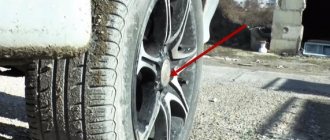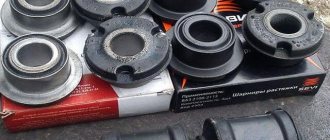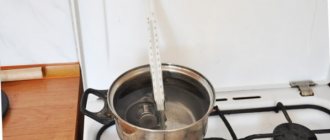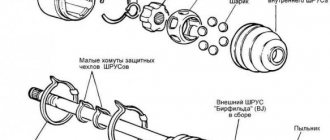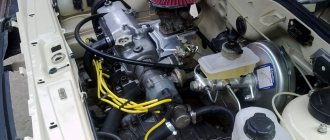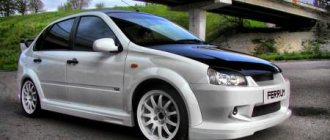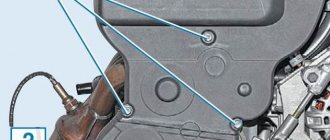The best manufacturers of CV joint boots
Each brand has an individual list of pros and cons that affect operation, as well as customer choice.
MARUICHI
Description. The Japanese company MARUICHI is considered one of the market leaders in the field of rubber-metal parts, which includes anthers. The brand is distinguished by proven quality, which is achieved by high-tech production and the use of durable materials.
We supply boots not only to the secondary market, but also to the assembly line, which allows customers to receive similar parts for their cars.
The boot is made of a rubber mixture, which has increased resistance to mechanical loads and frost resistance.
Spare parts can withstand temperatures down to -50 °C.
Equipment. The standard equipment includes the boot itself, good quality molybdenum grease, clamps, and a retaining ring. Often the kit also includes a hub nut.
Life time. The service life exceeds 3 years, with a guaranteed service life of 1 year.
Pros of MARUICHI
- High quality combined with a low price.
- Analogue to original spare parts for Japanese cars.
- Long-term operation due to wear resistance of rubber.
- Frost resistance, which is important for northern regions.
- Good packaging and inclusion of lubricant.
Cons of MARUICHI
- Narrow clamps.
- Some models supplied to the secondary market differ from the originals, which requires the correct selection of the optimal boot.
TRACK
Description. The domestic manufacturer TREC occupies a significant segment of the anther market in Russia. This is due to the introduction of innovations in production and high-quality products that have international quality certificates, including environmental ones.
The boot is made of high-strength polyurethane, which increases service life and resistance to mechanical damage. There are several series of anthers available on the market, differing in characteristics and configuration.
Equipment. The standard kit includes a boot, clamps and lubricant. In the classic series, only the boot is supplied.
Life time. The guaranteed service life is 12 months or 40,000 km. In practice, the actual duration of operation depends on operating conditions and compliance with all rules. The boot can protect the unit for more than 5 years if treated with care and appropriate maintenance.
Pros of TRACK
- In production, thermoplastic elastomer is used, created on a polyurethane basis, which increases the strength indicators relative to rubber three times.
- Resistance to temperatures ranging from -65°C to +110°C.
- They last a long time with proper installation and maintenance.
- Good price/quality ratio combined with a large selection.
- High quality durable stainless steel clamps.
Cons of TRACK
- It is difficult to select a boot with the required dimensions for a number of foreign cars, since the products are more aimed at the domestic market.
- There may be a defective batch under this brand, so it is worth checking the place of manufacture when purchasing.
HORSE
Description. The Russian company HORS is part of a diversified holding association that supplies spare parts to the secondary market. Rubber-metal products, including anthers, are considered one of the production lines.
The boot is made of silicone with a good level of frost resistance. This allows it to be used in northern regions.
The element retains elasticity at temperatures from - 50 C to + 250 C. Wear resistance, which is achieved through high-quality silicone, is taken into account. The difference is considered to be a good level of protection against any aggressive substances.
Equipment. The kit includes clamps, the cover itself and lubricant.
Life time. The guaranteed period is 1 year, but practice shows that the service life significantly exceeds 3 years with proper installation.
Pros of HORSE
- High-quality design with a seal at the clamp attachment point, which ensures structural strength and reduces the possibility of dirt penetration.
- Heat and frost resistance.
- Possibility of installation on domestic and foreign brands of cars.
- Long service even in difficult conditions.
Cons of HORSE
- There are low-quality copies in the form of fakes. They cost less than the originals.
SWAG
Description. SWAG's enterprises are located in Germany. Boots are among the aftermarket parts that are supplied to international markets. In the manufacture of spare parts, high-quality materials with increased resistance to damage, including mechanical damage, are used.
Despite the fact that the company supplies a number of models of anthers for assembly line assembly, the quality of the originals is much higher than the parts supplied to the secondary market. The difference will be a low price segment compared to competitors with European quality certificates.
Equipment. The kit includes a cover, clamps, lubricant, and may also include a retaining ring. Each series has its own equipment.
Life time. The warranty is issued for one calendar year. The duration of actual operation depends on many factors, but the average period exceeds two years.
Pros of SWAG
- Budget option with European quality.
- Large selection of anthers for all brands of cars.
- There are models similar to original spare parts for German and Czech cars.
Cons of SWAG
- A large number of fakes.
Lemforder
Description. Lemforder is part of a large concern that plays a leading role in the production of auto parts. The silicone boot is designed for long-term use and has all European and international quality certificates.
Rubber-metal products are supplied in branded boxes and with protective logos, as the percentage of counterfeit products is high.
Spare parts are similar to the original parts that are used to assemble German and American-made cars.
The difference between the products is also considered to be the ability to choose the best option for any brand of car without loss of service life.
Equipment. The kit includes clamps, boot and retaining ring. For some series, a special lubricant is provided, which allows you to extend the service life.
Life time. The warranty is issued for 12 months. The service life of the protective element is more than 5 years with proper maintenance and professional installation.
Pros of Lemforder
- Inexpensive case option with good quality.
- Proximity to original parts, which facilitates installation and installation.
- Long-term operation due to the resistance of silicone to negative factors.
Cons of Lemforder
- When purchasing, you will need to check the spare part for logos and special codes, the country of the manufacturer, since there are a very large number of fakes, which are not only low in cost, but also of poor quality.
- If a non-recommended lubricant is used, the boot may be subject to accelerated wear.
Replacement
Armed with new CV joints, also collect a set of necessary tools and materials. It will include:
- Set of heads;
- Spanners;
- Shoes;
- Dry rags;
- Grease for CV joints;
- Jack;
- Anthers.
Diagram of the CV joints
Now let's get down to work on replacing the CV joints:
- Determine the location where the repairs will be carried out. This could be an overpass, a garage with an inspection hole, or a room with a car lift.
- Stop the engine and apply the handbrake. Use chocks to block the wheels.
- Using a wheel wrench, remove the wheel bolts.
- Raise the required part of the car with a jack.
- Loosen the nut in the center of the CV joint. Keep an eye on the puck so you don't lose it. It is not included with the new CV joint.
- Armed with 13mm wrenches, unscrew the fasteners of the upper part of the ball joint. It is not necessary to perform a similar procedure with the lower part, since it will not interfere with the repair process.
- Using a pry bar, slightly rip the grooves off the support and move them aside.
- Knock the hub off the CV joint splines. To do this you will need a hammer and some kind of wooden stand.
- Remove the old damaged CV joint.
- Check for damage to the stem.
- Remove any remaining lubricant from the rod using a dry rag.
- Place a new grenade in the new location. This assembly should include a CV joint, boot, clamps, nuts, and retaining rings.
- When assembling the unit, do not forget to use high-quality lubricants. There shouldn’t be too much of it, but you shouldn’t feel too sorry either.
- Reassemble the parts in reverse order.
- By changing the CV joints, you can simultaneously check the condition of the brake pads. If they are in a sufficiently worn condition, it is advised to replace them at the same time. Anyway, you have already dismantled the knot.
- After completing the repair, check the car in action.
- It’s not uncommon for craftsmen without much experience to leave behind supposedly unnecessary parts after reassembly. Please note that everything that remains after assembly, and that is not the released elements that you replaced with new ones, has its place in the design of the car. Therefore, check where exactly these “extra” elements come from and install them in their rightful place.
Types of CV joint anthers
Boots for CV joints are presented in the form of special protective covers that ensure tight closure of the hinge assembly from the ingress of foreign substances and various dirt.
There are two types of anthers:
1. Internal, which is necessary to protect the CV joint in the interior of the vehicle assembly. It protects the element from temperature, various objects and dirt, as well as physical impact.
2. The external or external version of the boot provides protection to external elements. It must have increased resistance to wear and stress. Typically, such protective elements are elastic, since they are subject to compression and stretching during operation of the unit.
Take into account that the two types of anthers have individual characteristics and differ from each other.
Clamp fastener
Some European-made cars have switched to using clamp clamps, as they combine reliability and simplicity. To install them, special pliers for CV joint clamps are used.
Placing the clamp on the CV joint occurs in the following order:
- The required diameter is selected;
- The clamp is located on the boot. It should be installed without distortions;
- To perform crimping, clamp pliers are used. If they are unavailable, you can use pliers of a suitable size;
- Upon completion of work, you should check the reliability of fixation of the clamp.
The main advantage of clamping fasteners is that there is no need to purchase expensive special tools. Carrying out the work with conventional pliers will ensure high reliability and long service life.
Purpose and classification of anthers
Anthers have a standard purpose, which is divided into three types of actions:
- Protect the unit from moisture, dust or dirt.
- Keep lubricants clean.
- Lubricants are contained within the assembly.
Classification
It is necessary to highlight:
- Front mounted with front wheel drive. They are divided into front internal (near the wheel) and internal (near the automatic transmission, gearbox);
- Rear external and rear internal with installation near the gearbox.
Depending on the material used, the covers can be rubber (silicone) or thermoplastic with a polyurethane base.
The division is also carried out by manufacturer. There are original spare parts that are produced by the company itself, and duplicate ones produced by partners.
Find a CV joint for a Honda Honda
Selection of a cheap CV joint (grenade) from another car
Unique replacement of CV joint boots.mp4
Eternal CV joint boot.
Installing a universal CV joint boot on HONDA CRV and RENAULT LOGAN
CV joint (grenade) RUVILLE reviews
How to make an outer CV joint puller with your own hands / CV joint puller
https://youtube.com/watch?v=Y5s4cpiwYmw
Replacement and restoration of the CV joint, as well as the intermediate shaft on the Cherie Tigo
(Replacing internal CV joint)):)) Tripoid
Overview of CV joint lubricants
CV joint washing and lubrication in one motion.mp4
Also see:
- Chip keys for Honda car
- Honda Camshaft Sensor Replacement
- Painting a Honda cbr 600 motorcycle
- Honda VTZ 250 reviews
- Honda Adyssey in Kyrgyzstan
- Honda 929 2002 specifications
- Brake discs Honda SRV 2013
- Walking on a Honda HRV
- Bleeding the Honda SRV steering rack
- Fuel pump Honda Civic d15b
- Engine us Honda Dio 35
- Honda element soundproofing
- Honda Civic 6th generation Englishman
- Spoiler for Honda Civic ferio
- Motorcycle 110 Honda
Signs of boot failure
If there are any defects on the anthers, they need to be replaced. There are a number of signs by which you can understand that the protective case is no longer performing its function in full mode. Among them:
- The appearance of microcracks.
- Uneven wear on one side of the boot.
- A gap appears.
- The unit releases lubricant that seeps through the cover.
In all of these cases, the external or internal boot will need to be replaced with a new one.
Take into account that the operation of a damaged boot will lead to more serious damage that will occur if the hinge part of the assembly is contaminated.
Which CV joint boot is better to buy?
The choice of anthers is very large due to the extensive range and the presence of a significant number of well-known brands in this market segment.
When choosing, pay attention to a number of factors:
- The manufacturer must have a positive reputation.
- The boot is not a fake, that is, logos, markings and special codes, including the article number, are checked.
- The choice is made on the basis of similarity to the original native parts.
- The material from which the protective element is made is suitable for the terrain. An example would be the ability to operate in severe frost.
- When choosing rubber, plastic or silicone spare parts, take into account that rubber has a smaller margin of safety, and plastic parts may crack.
The number of ribs is also taken into account. 5-rib boots have greater wear resistance compared to a boot with 4 ribs.
When purchasing, you should immediately check the elements for elasticity and resistance to deformation. This will allow you to choose a strong case for the hinge and increase its service life.
Experts advise not to buy cheap or used items, as they have a shorter service life.
To come in
Already registered? Sign in here.
There are currently 0 users on the page
There are no users viewing this page.
Before considering the main topic of the article - which grenades are better for the VAZ 2114, you should first understand what this part is. A CV joint (otherwise called a grenade because of its characteristic shape) is an element of the front suspension of a car, extending from the hub of each wheel. It has an oblong shape with a thickening at the end. Its main purpose is to transmit torque at maximum rotation angles (reaching 70 degrees).
As for its service life, it can be noted that initially CV joints were created as elements with a very long service life (in some cases equal to the service life of the car itself). But, in practice, damage to the grenade occurs quite often, and the main reason for this is wear or cracks on the CV boot, allowing dust and dirt to get inside, violating the integrity of the structure and causing its damage.
Checking the damage to the grenade is quite simple - you just need to turn the car's wheels as far as possible in any direction and inspect the suspension. If the boots are damaged (that is, have cracks or tears), they should be replaced immediately. And in a situation where a grinding or other extraneous noise emanating from the suspension is heard while driving, conclusions can be drawn about the damage to the grenade and its failure.
In this case, it is categorically not recommended to continue driving - firstly, it is very dangerous and can lead to road accidents, and secondly, driving with a faulty CV joint can lead to the breakdown of a number of other parts and mechanisms, as a result of which the total cost of repairs is significantly will increase.
If the CV joint is damaged and noise is heard from the front suspension, it is absolutely forbidden to continue driving. This can not only lead to damage to other elements of the car, but is also very dangerous to life.
